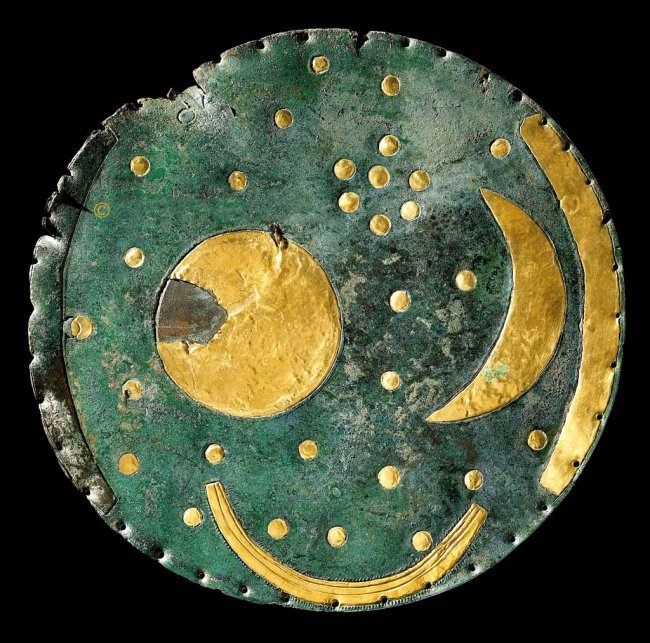MessageToEagle.com – A controversial Bronze Age disc known as the Nebra Sky Disc is one of the most fascinating and perhaps some would say, disputable archaeological finds of recent years.
It has been suggested that this old artifact represents 3,600 years old astronomical knowledge.
However there are doubts that the Nebra disc was used by prehistoric astronomers as a precision tool for gazing the sky.
Was the Nebra Sky Disc the first true representation of the cosmos, used for measuring astronomical phenomena or was it a tool used for shamanistic rituals?
“It’s a difficult question to answer, but I do not think it was used as an instrument used for observing objects in the sky,” said Curt Roslund, an astronomer at Gothenburg, Sweden. He argues that few features on the disc tend towards exact representation and that it is more likely to have been of symbolic value – perhaps used in shamanic rituals.
So what exactly is the Nebra disc and what was it used for?
Dated to 1600 BC, this bronze disc with gold-leaf decorations has a diameter of 32 cm and weighs around 4 pounds. It is patinated blue-green and embossed with gold leaf symbols of the Moon, Sun and stars and a curved gold band (interpreted as a sun boat) and additional gold band on the edge of the disc, which probably represent one of the horizons.
It was discovered by some treasure hunters using a metal detector in a prehistoric area of Mittelberg Hill near Nebra, a small town in the district of Burgenlandkreis of Saxony-Anhalt, 112 miles southwest of Berlin, Germany. Along with the disc, the hunters discovered two swords, two axes, a chisel, and fragments of armlets.
The discoverers’ unprofessional removal from the ground unfortunately damaged the fragile disc’s outer rim and one of its 32 stars was lost.
Was the disc once attached to something?
Many researchers believe the disc is the oldest known representation of the cosmos. Was the Nebra Disc once an astronomical instrument to determine planting and harvest times for an agricultural society who lived in Bronze Age? It has been determined, the angle between the pair of arcs on either side of the disc is exactly 82 degrees.
Does it relate to the suns passage across the sky in central Europe which measures also exactly 82 degrees?
The pair of arcs may represent the sun solstices for Mittelberg Hill, where in fact the disc was found. It would mean that the Bronze Age people of central Europe were able to make very advanced celestial measurements much earlier than diverse textbooks suggested.
Since 2004, at least, the Nebra Disc has remained a subject of a deep controversy.
See also:
- Ancient Papyrus Reveals Millennia Old Astronomical Secret: The ‘Demon Star’ Algol Does Exist
- Astrolabe: A Beautiful, Mysterious And Sophisticated Computer Of The Ancient World
- Controversial 5,500-Year-Old Sumerian Star Map Of Ancient Nineveh Reveals Observation Of Köfels’ Impact Event
On the contrary, the Nebra Disc is old and genuine. Numerous tests conducted by the Institute for Archaeological Research in Halle, Germany showed the artifact’s true antiquity. It has been concluded that the artifact represents a complex astronomical clock for the synchronization of solar and lunar calendars.
We must not forget that the sky disc of Nebra was found near Europe’s oldest observatory in Goseck – first identified from aerial photographs.
Goseck represents the remains of what is thought to be Europe’s oldest observatory that consists of a huge circle, 246 feet in diameter and is dated to approximately 4900 BC.
Were the intriguing details on the disc based on previous sky observations made by the ancients gathered at the primitive observatory at Goseck?
Copyright © MessageToEagle.com. All rights reserved. This material may not be published, broadcast, rewritten or redistributed in whole or part without the express written permission of MessageToEagle.com








